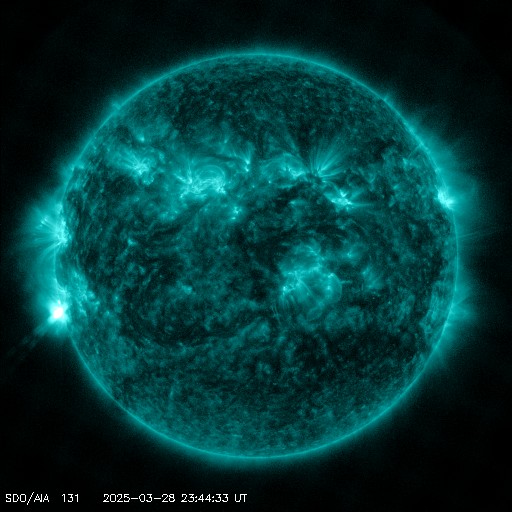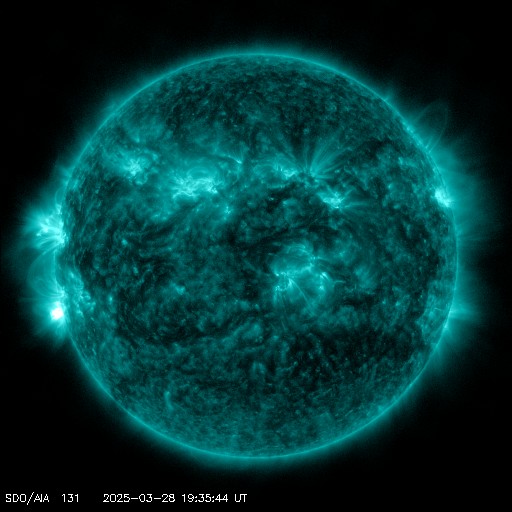Viewing archive of Thursday, 19 June 2003
Geophysical report
Any mentioned solar flare in this report has a scaling factor applied by the Space Weather Prediction Center (SWPC). Because of the SWPC scaling factor, solar flares are reported as 42% smaller than for the science quality data. The scaling factor has been removed from our archived solar flare data to reflect the true physical units.
Solar and Geophysical Activity Summary 2003 Jun 19 0245 UTCPrepared by the NOAA © SWPC and processed by SpaceWeatherLive.com
Joint USAF/NOAA Solar and Geophysical Activity Summary
SGAS Number 170 Issued at 0245Z on 19 Jun 2003 This report is compiled from data received at SWO on 18 JunA. Energetic Events
Begin Max End Rgn Loc Xray Op 245MHz 10cm Sweep 2227 2255 2312 0386 M6.8 1200 2100 II/IV
B. Proton Events
The greater than 10 Mev proton fluxes at
geosynchronous orbit reached event threshold at 18/2050Z and due to
the recent activity the exact source for this particle event is not
certain at this time but is most likely from the M6.8 x-ray flare
from 17 June..
C. Geomagnetic Activity Summary
The geomagnetic field was at
predominantly minor to major storm levels with an isolated period of
severe storm conditions seen at high latitudes between 18/0600 and
0900Z. A co-rotating integrated region preceding a recurrent high
speed coronal hole stream and is believed to responsible for the
storm conditions.
D. Stratwarm
None
E. Daily Indices: (real-time preliminary/estimated values)
10 cm 120 SSN 099 Afr/Ap 045/054 X-ray Background B3.2 Daily Proton Fluence (flux accumulation over 24 hrs) GT 1 MeV 2.5e+07 GT 10 MeV 1.4e+06 p/(cm2-ster-day) (GOES-8 satellite synchronous orbit W128 degrees) Daily Electron Fluence GT 2 MeV 2.30e+06 e/(cm2-ster-day) (GOES-12 satellite synchronous orbit W75 degrees) 3 Hour K-indices Boulder 5 5 6 6 3 5 4 3 Planetary 5 6 7 6 4 4 4 4
F. Comments
None PLAIN K-Indices: On 16 June, it was determined that a scaling problem exists with the Boulder magnetometer instrument. While this problem, and its fix are being investigated the primary instrument for Boulder K-indices has been switched to the Boulder USGS (via Domsat) magnetometer, effective 1500 UTC on 16 June. GOES Protons: To ensure continued operational monitoring of important energetic particle data, it is necessary to reassign primary/secondary designations for the GOES Space Environment Monitor (SEM) detectors. GOES 11 (113W) will become the primary satellite for protons. The transition from GOES 8 to GOES 11 was scheduled for 18 June, but has been delayed until 19 June. GOES 12 will continue as the primary satellite for magnetometer, X-ray, and electron measurements. GOES 10 (135W) will be the secondary satellite for all SEM sensors - magnetometer, X-ray, and energetic particles. Because of the degraded state of the proton data on GOES-10, its designation as the secondary source for proton data is a short-term solution. More permanent solutions have been identified and are being evaluated. Users will be notified when we define and schedule a permanent fix. Further details can be found at http://www.sec.noaa.gov/GOES.html. 99999
All times in UTC
Current data suggests there is a slight possibility for aurora to appear at the following high latitude regions in the near future
Fairbanks, AKLatest news
Latest forum messages
AR4046 109Aurora photography hints for those of us with smartphones 48Large Coronal Hole 25 178Incoming & Unnumbered Active Regions 1655LASCO Data Not Updating 5
More topicsSupport SpaceWeatherLive.com!
A lot of people come to SpaceWeatherLive to follow the Sun's activity or if there is aurora to be seen, but with more traffic comes higher server costs. Consider a donation if you enjoy SpaceWeatherLive so we can keep the website online!

Latest alerts
00:00 UTC - Solar flare
Moderate M1.79 flare
Friday, 28 March 2025
23:36 UTC - Radio Blackout
Minor R1 radio blackout in progress (≥M1 - current: M1.04)
21:24 UTC - Hemispheric Power Index
The OVATION model predicts the Hemispheric Power Index to reach 51GW at 21:59 UTC
19:45 UTC - Solar flare
Moderate M1.16 flare
19:27 UTC - Radio Blackout
Minor R1 radio blackout in progress (≥M1 - current: M1.1)
Space weather facts
| Last X-flare | 2025/03/28 | X1.1 |
| Last M-flare | 2025/03/28 | M1.7 |
| Last geomagnetic storm | 2025/03/27 | Kp5 (G1) |
| Spotless days | |
|---|---|
| Last spotless day | 2022/06/08 |
| Monthly mean Sunspot Number | |
|---|---|
| February 2025 | 154.6 +17.6 |
| March 2025 | 128.3 -26.4 |
| Last 30 days | 128.3 -23.7 |




